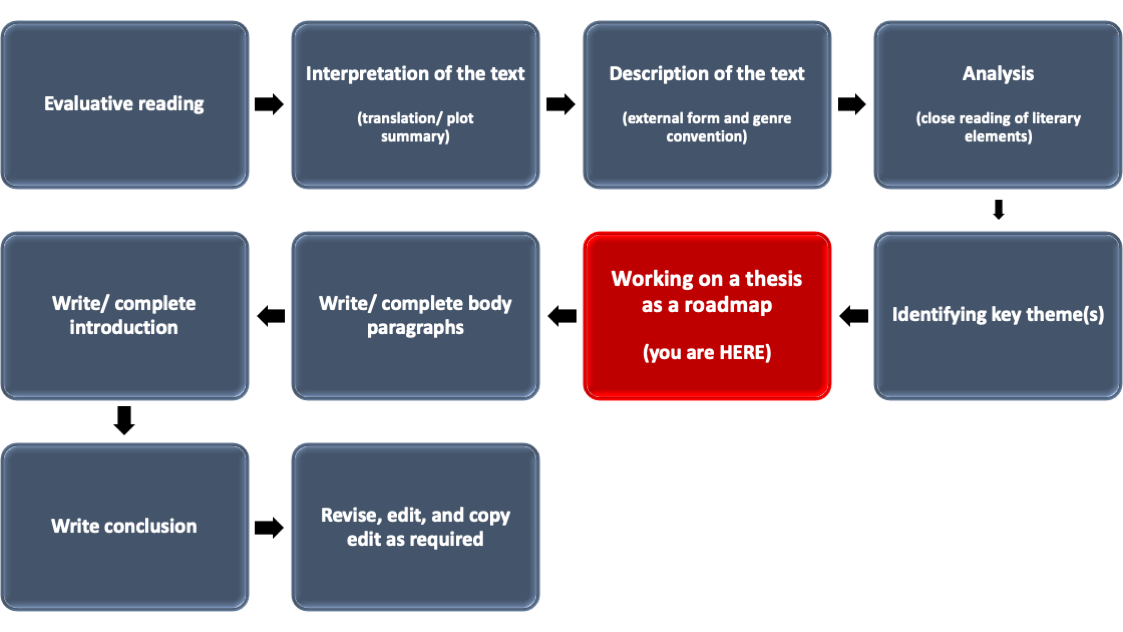Building a Better Thesis Statement
Building a Better Thesis Statement by Neta Gordon is licensed under a Creative Commons Attribution 4.0 International License, except where otherwise noted.
Building a Better Thesis Statement by Neta Gordon is licensed under a Creative Commons Attribution 4.0 International License, except where otherwise noted.
1
To start: the quality and sophistication of a thesis statement will largely depend on the quality and sophistication of the literary analysis. That said, the process of configuring a complex thesis statement is a helpful step for organizing and/or finding gaps in analysis. Also, the process can help students embed a sense of development and logic into their essay.
The goal of this stage in essay writing is to craft a thesis statement that has a three-part structure (set up – intervention – argumentative statement). The complex thesis statement will serve as a road-map to the rest of the essay, with each part of the thesis connecting to subsequent body paragraphs.
I

1
An interactive H5P element has been excluded from this version of the text. You can view it online here:
https://ecampusontario.pressbooks.pub/literaryanalysis/?p=23#h5p-14
2
An interactive H5P element has been excluded from this version of the text. You can view it online here:
https://ecampusontario.pressbooks.pub/literaryanalysis/?p=32#h5p-19
An interactive H5P element has been excluded from this version of the text. You can view it online here:
https://ecampusontario.pressbooks.pub/literaryanalysis/?p=32#h5p-15
3
The speaker is not a persona, but an older version of the “I” in the poem.
Every stanza but the last includes three lines, usually of pentameter, and the last two lines form a rhyming couplet broken up by a stanza break.
The speaker describes every scene.
The use of enjambment is far more frequent, with many thoughts running over the end of poetry lines. The third line, and also the final two lines, are end-stopped.
Analysis:
The image can be read metaphorically, whereby the knelling bells might be compared to bells that toll at a funeral, and whereby the vehicle “classes” can be compared with the tenor “life”.
See, for example, most of the first stanza, as well as the reference to “ten o’clock [when] the ambulance arrived” (and 14), the “[n]ext morning” 916) and “the first time in six weeks” (18).
Also, many descriptions indicate the age of characters.
See “[s]nowdrops/[a]nd candles [which] soothed the bedside” (16-17).
Analysis:
(tenor = injury/bruise, vehicle = poppy, ground = the colour red, cause of forgetfulness, something small, yet powerful.
reinforcing the idea that the death of a child disrupts normal conceptions of the life cycle.
suggesting the way poem focuses on how to manage grief.
indicates the implicit perspective of an older speaker who is reflecting on a family tragedy from an emotional distance.
4
5
An interactive H5P element has been excluded from this version of the text. You can view it online here:
https://ecampusontario.pressbooks.pub/literaryanalysis/?p=179#h5p-15
An interactive H5P element has been excluded from this version of the text. You can view it online here:
https://ecampusontario.pressbooks.pub/literaryanalysis/?p=179#h5p-18
6
An interactive H5P element has been excluded from this version of the text. You can view it online here:
https://ecampusontario.pressbooks.pub/literaryanalysis/?p=207#h5p-17
7
It contains all the conventions of a dramatic monologue, including a speaker whose persona is clearly distinct from that of the poet (a car mechanic), a silent auditor who listens to the speech (a woman who has brought in her car to have the brake fluid topped up), an occasion for the speech (the mechanic explaining to the woman how to top up the brake fluid), and – arguably – a sense of the ironic distance between author and speaker (Armitage’s tone is critical, as the mechanic’s manner toward the woman is patronizing, as is made most clear in the final words, “Tell your husband” [line 24]).
for example when the speaker says, “Go on, it won’t / eat you” (lines 4-5), or in the frequent reference to the silent auditor as “love” (lines 1, 10, 19, 22). Further, the rhythms of plain speech are reinforced by the consistent use of both enjambment and caesura throughout the poem. Finally, the speech of the mechanic seems realistic due to his use of technical language to describe the car parts, for example the “fan-belt” (line 5), the “spade connector” (line 7), and the “float-chamber” (line 13).
Each line is written in hendecasyllables (or, each line has eleven syllables) and the rhyme scheme for each stanza is ABBA, though many of the rhymes are slant rhymes (or words that almost rhyme, such as “fluid” [line 2] and “toolkit” [line 3]).
Review the following:
An interactive H5P element has been excluded from this version of the text. You can view it online here:
https://ecampusontario.pressbooks.pub/literaryanalysis/?p=74#h5p-20
Copy and paste the following template into the text box below to create a more complex thesis statement. On the next slide you can export your response to continue your work on it.
An interactive H5P element has been excluded from this version of the text. You can view it online here:
https://ecampusontario.pressbooks.pub/literaryanalysis/?p=74#h5p-13
II